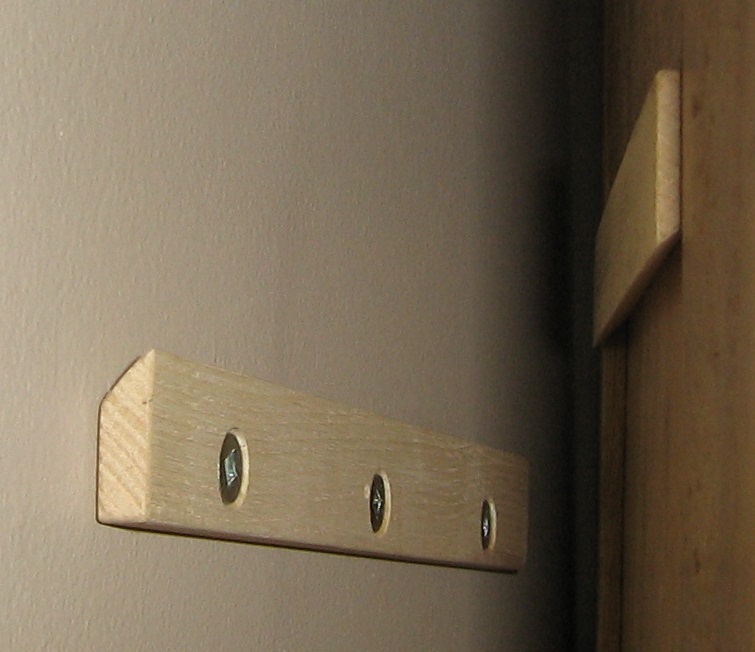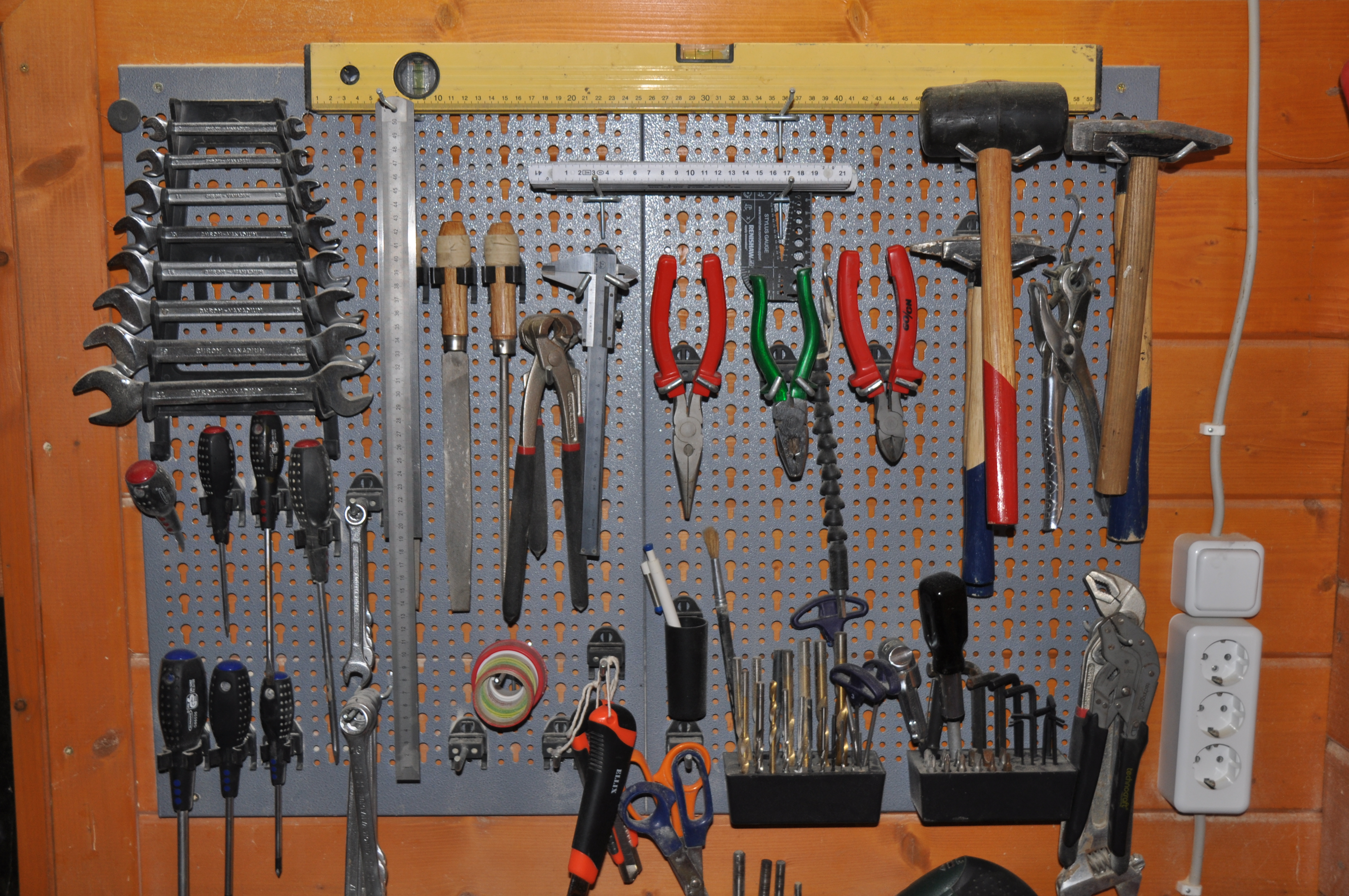|
French Cleat
A French cleat is a way of securing a cabinet, mirror, artwork or other object to a wall.''Fine Woodworking'', p.107, Taunton Press, 2004 It is a molding with a 30–45 degree slope used to hang cabinets or other objects. French cleats can be used in pairs, or with a cleat mounted to the wall and a matching edge cut into the object to be hung. The wall side of a French cleat can be mounted securely without having to hold the full weight of the cabinet while securing it. The cleat will not be seen while in use, so it does not matter where it is drilled; this means that it can be screwed into wall studs relatively independent of the lateral position of the cabinet. The cleat can be the full length of the cabinet, so it allows supporting the cabinet at least at every stud behind it. If the wall cleat is left slightly shorter than the cabinet, the cabinet can be shifted left and right slightly after it is hung, for perfect positioning. Once the cleat is secured to the wall, the c ... [...More Info...] [...Related Items...] OR: [Wikipedia] [Google] [Baidu] |
French Cleat
A French cleat is a way of securing a cabinet, mirror, artwork or other object to a wall.''Fine Woodworking'', p.107, Taunton Press, 2004 It is a molding with a 30–45 degree slope used to hang cabinets or other objects. French cleats can be used in pairs, or with a cleat mounted to the wall and a matching edge cut into the object to be hung. The wall side of a French cleat can be mounted securely without having to hold the full weight of the cabinet while securing it. The cleat will not be seen while in use, so it does not matter where it is drilled; this means that it can be screwed into wall studs relatively independent of the lateral position of the cabinet. The cleat can be the full length of the cabinet, so it allows supporting the cabinet at least at every stud behind it. If the wall cleat is left slightly shorter than the cabinet, the cabinet can be shifted left and right slightly after it is hung, for perfect positioning. Once the cleat is secured to the wall, the c ... [...More Info...] [...Related Items...] OR: [Wikipedia] [Google] [Baidu] |
Cabinetry
A cabinet is a case or cupboard with shelves and/or drawers for storing or displaying items. Some cabinets are stand alone while others are built in to a wall or are attached to it like a medicine cabinet. Cabinets are typically made of wood (solid or with veneers or artificial surfaces), coated steel (common for medicine cabinets), or synthetic materials. Commercial grade cabinets usually have a melamine-particleboard substrate and are covered in a high pressure decorative laminate, commonly referred to as Wilsonart or Formica. Cabinets sometimes have one or more doors on the front, which are mounted with door hardware, and occasionally a lock. Cabinets may have one or more doors, drawers, and/or shelves. Short cabinets often have a finished surface on top that can be used for display, or as a working surface, such as the countertops found in kitchens. A cabinet intended to be used in a bedroom and with several drawers typically placed one above another in one or more colum ... [...More Info...] [...Related Items...] OR: [Wikipedia] [Google] [Baidu] |
Taunton Press
Taunton Press is a publisher of periodicals, books, and websites for the hobbyist and building trades based in Newtown, Connecticut. It was established in 1975 by Paul Roman and his wife Jan. Publications and Products Periodicals published by Taunton Press include: * ''Fine Woodworking'' * ''Fine Homebuilding'' * ''Fine Gardening'' * ''Threads'' * ''Kitchen Garden'' (retired) * ''CraftStylish'' (retired) * ''Inspired House'' (retired) In addition to traditional print media products, Taunton Press maintains a number of online resources and communities including: * GreenBuildingAdvisor.com Taunton Press also publishes books on topics covered in their magazines: woodworking, home building, home design, cooking, gardening and crafts. Popular publications have included Sarah Susanka's ''Not So Big'' home design series, New York Times Bestseller ''The Food You Crave'' by Ellie Krieger, ''The Crocheted Prayer Shawl Companion'' by Janet Bristow and Victoria A. Cole-Galo, ''Graphic Gu ... [...More Info...] [...Related Items...] OR: [Wikipedia] [Google] [Baidu] |
Moulding (decorative)
Moulding (spelled molding in the United States), or coving (in United Kingdom, Australia), is a strip of material with various profiles used to cover transitions between surfaces or for decoration. It is traditionally made from solid milled wood or plaster, but may be of plastic or reformed wood. In classical architecture and sculpture, the moulding is often carved in marble or other stones. A "plain" moulding has right-angled upper and lower edges. A "sprung" moulding has upper and lower edges that bevel towards its rear, allowing mounting between two non-parallel planes (such as a wall and a ceiling), with an open space behind. Mouldings may be decorated with paterae as long, uninterrupted elements may be boring for eyes. Types Decorative mouldings have been made of wood, stone and cement. Recently mouldings have been made of extruded PVC and Expanded Polystyrene (EPS) as a core with a cement-based protective coating. Synthetic mouldings are a cost-effective alternative ... [...More Info...] [...Related Items...] OR: [Wikipedia] [Google] [Baidu] |
Wall Stud
A wall stud is a vertical repetitive framing member in a building's wall of smaller cross section than a post. It is a fundamental element in frame building. Etymology ''Stud'' is an ancient word related to similar words in Old English, Old Norse, Middle High German, and Old Teutonic generally meaning ''prop'' or ''support''."Stud". def. 1. ''Oxford English Dictionary'' Second Edition on CD-ROM (v. 4.0) © Oxford University Press 2009 Other historical words with similar meaning are ''quarter'' and ''scantling'' (one sense meaning a smaller timber, not necessarily the same use). ''Stick'' is a colloquial term for both framing lumber (timber) and a "timber tree" (a tree trunk good for using as lumber (timber)); thus, the names ''"stick and platform"'', ''"stick and frame"'', ''"stick and box"'', or simply ''stick framing''. The stud height usually determines the ceiling height, thus sayings like: "...These rooms were usually high in stud..." Purpose Studs form walls and may carry ... [...More Info...] [...Related Items...] OR: [Wikipedia] [Google] [Baidu] |
Tool Board
A tool board or tool wall is a board for hanging tools onto, and is typically mounted on a wall or as a folding cabinet which rolls on wheels. Such boards are often found in workshops, and often consists of plates made of wood or metal. The tools are often hanged onto the tool board via hooks, screws, cane holders or other types of tool holders, and these are often attached to the board through pegs. Compared to a toolbox or tool cart, a tool board can give a better overview so that it is easy to find the needed tools for a job. A drawback of a tool board is that it may occupy a large area on a wall, and that the tools can get less protection from dust. Some recommend to hang heavier tools like hammers at the bottom, and especially wooden tool boards may bend or break from heavy tools if the board is made of fiberboard or other weaker materials. Ready-made tool boards Ready-made tool boards are often made of either perforated metal plates or perforated hardboard, and often h ... [...More Info...] [...Related Items...] OR: [Wikipedia] [Google] [Baidu] |



